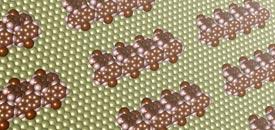

02/27/2017

© 2017 Daniel Packwood
There is more to entropy than the concept of disorder, a team from the AIMR at Tohoku University and the iCeMS at Kyoto University has shown. They modeled entropy’s role in molecular self-assembly reactions and found that, under certain conditions, using entropy rather than chemistry to control a reaction can enhance the formation of ordered nanostructures1. This discovery is significant for the manufacture of nanoscale electronics.
Most methods for manufacturing electronic components employ top-down approaches that involve ‘chiseling away’ at large structures. In contrast, bottom-up methods involve connecting small parts to form larger structures. As electronic components become ever smaller, there is an increasing push to use bottom-up processes to fabricate them. A particularly promising bottom-up method is molecular self-assembly in which groups of molecules spontaneously cluster together to form complex structures.
“Using molecular self-assembly, it’s currently possible to create tiny electrical wires with diameters of just a few carbon atoms,” says Daniel Packwood, leader of the research team. “By improving our ability to control the molecular self-assembly process, we can imagine moving from making tiny electrical wires to making tiny electrical circuits, and eventually to tiny electrical devices.”
To better understand the factors controlling the self-assembled structures that form, Packwood and colleagues examined the self-assembly of a series of anthracene-based organic molecules on a copper surface. Two factors are at play: chemical control — a measure of the strength of the chemical interaction between molecules; and entropic control, which varies according to the temperature the reaction is run at. The team considered the conditions under which wire-like structures formed, as opposed to disordered islands of molecules clustered on the metal’s surface.
“We first deduced an accurate mathematical formula for entropic control,” Packwood explains. “By studying how this formula worked, we could unambiguously deduce the effects of entropic control.” By running a simulation of the self-assembling reaction, any effects not explained by the formula for the entropic control could thus be identified as effects of chemical control.
Surprisingly, the team showed that adjusting the reaction temperature to increase entropic control of a reaction made it more likely that large disordered islands of molecules would break up into their molecular components again — freeing them to form ordered wire-like structures and increasing the proportion of ordered structures that ultimately form.
“Our results show that a careful analysis of entropy, beyond the broad concept of disorder, is necessary to properly understand how entropy affects molecular self-assembly,” Packwood says. “We intend to apply these rules to a real laboratory setting and demonstrate their value in producing new materials,” he adds.
This research highlight has been approved by the authors of the original article and all information and data contained within has been provided by said authors.